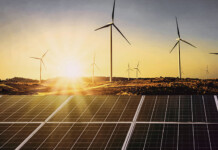As one of Australia’s leading experts on distributed energy resources (DER), CSIRO’s Dr Gabrielle Kuiper believes the grid-edge revolution isn’t just technological—it’s also social and cultural.
In 1992, a young Gabrielle Kuiper was completing undergraduate studies at the University of Canterbury in New Zealand when she attended a presentation by Greenpeace’s Kirsty Hamilton on the effects of climate change. It ended up being a pivotal moment, with Kuiper throwing herself into climate activism and eventually reshaping her academic path.
“My involvement with environmental activism, especially on climate change, prompted me to apply for an Honours scholarship to the Research School of Earth Sciences at The Australian National University (ANU). I thought that understanding Earth sciences might be a way for me to address the environmental devastation,” she explains.
Kuiper was awarded the scholarship and also completed a graduate diploma in science communication at ANU before becoming one of the first PhD students at the Institute for Sustainable Futures (ISF) at The University of Technology Sydney (UTS).
“I had considered I might do further study in Earth sciences after my honours, but it became clear to me that what was going to be most rewarding for me was not undertaking scientific research itself, but engaging with the world to reduce emissions,” she says.
“My PhD started from the question of how can science inform policy making for sustainability?”
Related article: Gridlocked: The state of transmission in the transition
The changing face of energy distribution
DER became Dr Kuiper’s specialist focus after a Churchill Fellowship saw her travel across North America and Europe to study the future of clean, smart distribution networks. She is now considered one of Australia’s leading experts on the subject, which includes rooftop solar, batteries, smart appliances, and electric vehicles. She recently joined CSIRO, Australia’s national science agency, in leading research to support the energy transition in Southeast Asia.
“The Churchill Fellowship in 2018 was an extraordinary opportunity. That’s when it became clear to me that the revolution was in distribution: distributed energy resources, or DER, were flipping the operation of electricity networks on their head,” she explains.
“The so-called grid edge—people’s homes and businesses—were now becoming generators, potentially hosting storage as well as flexible demand. Despite the radical change occurring, I was surprised there was relatively little interest in DER uptake and integration because it was primarily small-scale investment by families and businesses, rather than large-scale infrastructure investment involving multi-million or billion-dollar financial deals.
“When I travelled on the Churchill Fellowship, electricity distribution networks were just beginning to become smarter. They still have a long way to go, but I was particularly inspired by the British Energy Networks Association leading the change to DER providing ‘flexibility services’—the use of household and business resources to provide what Australians would call ‘network support services’, massively reducing the costs of maintaining and upgrading distribution networks.”
Research suggests flexibility markets will save UK grid up to £40 billion by 2050.
“Britain saw the opportunities for DER to reduce costs for consumers in a major way very early on. The rest of the world, including Australia, is still catching up with the opportunity for DER to provide network support services at scale,” Dr Kuiper says.
“To realise this potential in Australia, we need to reform the economic regulation of distribution networks.”

The overlooked potential of DER
Dr Kuiper says the biggest challenge for DER in Australia has been persuading policymakers and energy market institutions to take it seriously, giving it equal attention to large-scale renewables and storage.
“There’s a tendency to focus on big infrastructure,” she says.
“For example, the Integrated System Plan has been focused on transmission investment, especially interconnectors, prioritising investment in new expensive infrastructure over making best use of existing distribution networks. Particularly in the sub-transmission networks, there is significant untapped capacity.”
Australia has significant opportunity to enable cheaper, faster decarbonisation through optimising distributed energy resources. A meta-analysis conducted by Dr Kuiper for IEFFA in 2024 found Australia could reduce transition costs by $19 billion in net present value by 2040 by making optimal use of DER, with savings in large-scale generation and storage, and both transmission and distribution network investment.
Dr Kuiper points to Western Australia’s grid as an example of forward-thinking DER integration.
“I think the example set by Western Power is phenomenal: they analysed their network and realised that 52% of their line length served just 3% of their customers,” she says.
“Western Power saw that with rooftop solar, battery storage, and smart network management, much of that rural network could be replaced by standalone power systems (SAPS) and microgrids.
“Very few networks will have scarce customer figures like that, but it shows the opportunity to think differently about local distribution. Britain is doing significant work on local energy planning, while most Australian local governments haven’t been involved in electricity planning—it’s an opportunity yet to be realised.
“The shift to planning from the grid edge, looking first at planning for local energy and electrified transport needs is going to be vital for reducing the cost of the transition and increasing resilience.”
Related article: How much rooftop solar capacity can Australia handle?
Opportunities abroad and at home
Dr Kuiper’s work at CSIRO is focused on supporting DER integration in Australia and across Southeast Asia, where there is growing interest from countries like Malaysia, Indonesia, Thailand, and Vietnam.
“Hanoi, for example, will ban all fossil fuel-powered motorbikes and scooters within its central Ring Road 1 starting July 1, 2026, which will dramatically reduce noise and air pollution and is supporting opportunities for local electric scooter manufacturing,” Dr Kuiper says.
“Indonesia has announced a target for solar and battery storage across 80,000 rural and remote villages. Vietnam has a target for 50% of households to have rooftop solar by 2030.
“CSIRO—with Australian Government support—is engaging with governments, regulators, distribution networks and industry players to build capacity for DER uptake and integration, for example, advising on the uptake of smart inverter standards and the installation of battery energy storage systems (BESS) in distribution networks.”
Here in Australia, Dr Kuiper is excited about the introduction of vehicle-to-grid (V2G) charging.
“Batteries on wheels—EVs—offer enormous opportunities,” she says.
“My favourite fact of the moment is that the city of Shanghai is installing between 30,000 and 50,000 vehicle-to-grid chargers by 2030. If you have vehicles plugged in to all those bi-directional charging points, the system could equal a medium-sized power station feeding back into the grid, with immense implications for emergency supply and resilience.
“EVs are mobile batteries, so you can drive them where they’re needed for emergency power. That’s going to be increasingly important for adaptation. It’s great we’ve seen the announcement of three V2G pilots from Amber, Origin and AGL in the last couple of months. CSIRO has been doing excellent research on V2G in conjunction with Essential Energy, including trials of data driven charging and discharging strategies.”
Dr Kuiper also points out that DER includes generation, storage, and flexible demand.
“People often forget the third of these, but it is the most cost effective and the more flexible demand we have available, the faster we can move to a high penetration of renewable energy.
“I’d like to see governments support the deployment of more household and business flexible demand, starting with the inclusion of flexibility requirements into major household appliances, especially hot water systems, air conditioning and pool pumps. Greater support for smart electrification of commercial and industrial demand is also needed.”







